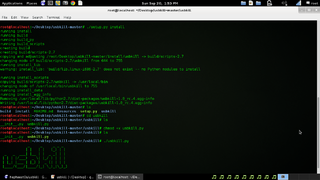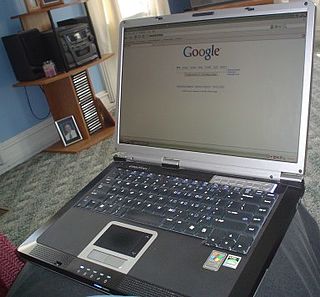Pretty Good Privacy (PGP) is an encryption program that provides cryptographic privacy and authentication for data communication. PGP is used for signing, encrypting, and decrypting texts, e-mails, files, directories, and whole disk partitions and to increase the security of e-mail communications. Phil Zimmermann developed PGP in 1991.
In cryptography, plaintext usually means unencrypted information pending input into cryptographic algorithms, usually encryption algorithms. This usually refers to data that is transmitted or stored unencrypted.
Hushmail is an encrypted proprietary web-based email service offering PGP-encrypted e-mail and vanity domain service. Hushmail uses OpenPGP standards. If public encryption keys are available to both recipient and sender, Hushmail can convey authenticated, encrypted messages in both directions. For recipients for whom no public key is available, Hushmail will allow a message to be encrypted by a password and stored for pickup by the recipient, or the message can be sent in cleartext. In July, 2016, the company launched an iOS app that offers end-to-end encryption and full integration with the webmail settings. The company is located in Vancouver, British Columbia, Canada.
The Encrypting File System (EFS) on Microsoft Windows is a feature introduced in version 3.0 of NTFS that provides filesystem-level encryption. The technology enables files to be transparently encrypted to protect confidential data from attackers with physical access to the computer.

TrueCrypt is a discontinued source-available freeware utility used for on-the-fly encryption (OTFE). It can create a virtual encrypted disk within a file, or encrypt a partition or the whole storage device.
Disk encryption software is computer security software that protects the confidentiality of data stored on computer media by using disk encryption.
Cryptography is the practice and study of encrypting information, or in other words, securing information from unauthorized access. There are many different cryptography laws in different nations. Some countries prohibit export of cryptography software and/or encryption algorithms or cryptoanalysis methods. Some countries require decryption keys to be recoverable in case of a police investigation.
The Linux Unified Key Setup (LUKS) is a disk encryption specification created by Clemens Fruhwirth in 2004 and originally intended for Linux.
Disk encryption is a technology which protects information by converting it into code that cannot be deciphered easily by unauthorized people or processes. Disk encryption uses disk encryption software or hardware to encrypt every bit of data that goes on a disk or disk volume. It is used to prevent unauthorized access to data storage.
United States v. Hubbell, 530 U.S. 27 (2000), was a United States Supreme Court case involving Webster Hubbell, who had been indicted on various tax-related charges, and mail and wire fraud charges, based on documents that the government had subpoenaed from him. The Fifth Amendment provides that no person "shall be compelled in any criminal case to be a witness against himself." The Supreme Court has, since 1976, applied the so-called "act-of-production doctrine". Under this doctrine, a person can invoke his Fifth Amendment rights against the production of documents only where the very act of producing the documents is incriminating in itself.
This is a technical feature comparison of different disk encryption software.

The Fifth Amendment to the United States Constitution creates several constitutional rights, limiting governmental powers focusing on criminal procedures. It was ratified, along with nine other articles, in 1791 as part of the Bill of Rights.

The All Writs Act is a United States federal statute, codified at 28 U.S.C. § 1651, which authorizes the United States federal courts to "issue all writs necessary or appropriate in aid of their respective jurisdictions and agreeable to the usages and principles of law."
Key disclosure laws, also known as mandatory key disclosure, is legislation that requires individuals to surrender cryptographic keys to law enforcement. The purpose is to allow access to material for confiscation or digital forensics purposes and use it either as evidence in a court of law or to enforce national security interests. Similarly, mandatory decryption laws force owners of encrypted data to supply decrypted data to law enforcement.
United States v. Fricosu, 841 F.Supp.2d 1232, is a federal criminal case in Colorado that addressed whether a person can be compelled to reveal his or her encryption passphrase or password, despite the U.S. Constitution's Fifth Amendment protection against self-incrimination. On January 23, 2012, judge Robert E. Blackburn held that under the All Writs Act, Fricosu is required to produce an unencrypted hard drive.

United States v. Cotterman,, is a United States court case in which the United States Court of Appeals for the Ninth Circuit held that property, such as a laptop and other electronic storage devices, presented for inspection when entering the United States at the border may not be subject to forensic examination without a reason for suspicion, a holding that weakened the border search exception of the Fourth Amendment to the United States Constitution.
United States v. Kirschner, 823 F. Supp. 2d 665, was a federal criminal case in Michigan. The defendant had previously been indicted by a grand jury under three counts of receipt of child pornography under 18 U.S.C. § 2252A(a)(2)(A). The government sought to use a grand jury subpoena post-indictment to acquire additional evidence: the contents of an encrypted file from the defendant's hard drive.

Proton Mail is an end-to-end encrypted email service founded in 2013 headquartered in Plan-les-Ouates, Switzerland. It uses client-side encryption to protect email content and user data before they are sent to Proton Mail servers, unlike other common email providers such as Gmail and Outlook.com. The service can be accessed through a webmail client, the Tor network, or dedicated iOS and Android apps.

USBKill is anti-forensic software distributed via GitHub, written in Python for the BSD, Linux, and OS X operating systems. It is designed to serve as a kill switch if the computer on which it is installed should fall under the control of individuals or entities against the desires of the owner. It is free software, available under the GNU General Public License.

An evil maid attack is an attack on an unattended device, in which an attacker with physical access alters it in some undetectable way so that they can later access the device, or the data on it.







